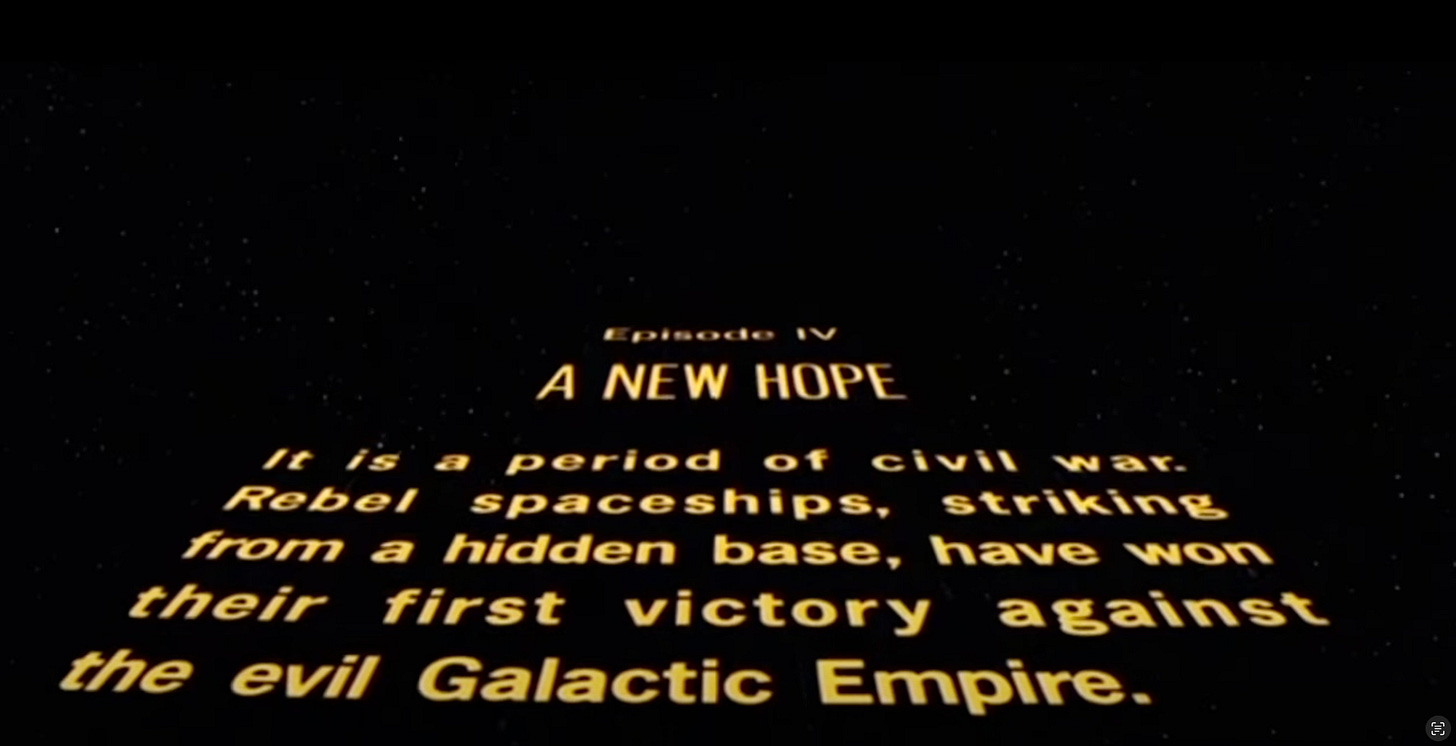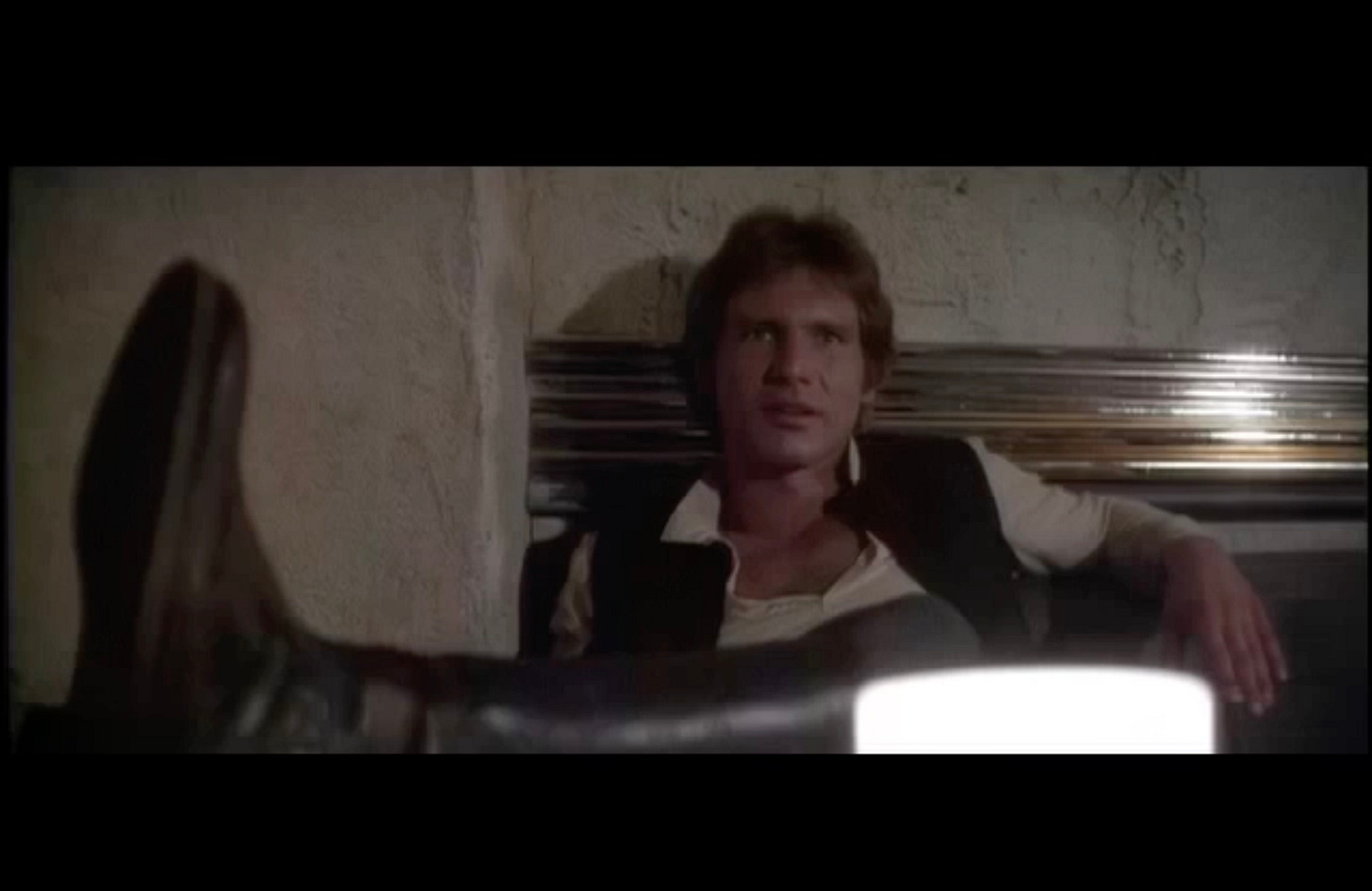I was eight years old in the summer of 1977, and I had no desire to see Star Wars.
It’s a very odd thing to remember. There was no buzz about the movie, at least in my neighborhood. None of my friends expressed any desire to see it. When I entered the third grade that fall, none of my classmates had Star Wars stickers or t-shirts or book covers or anything else; the girls in the class were more into Shaun Cassidy than Luke Skywalker.
Of course I knew what Star Wars was in the summer of ‘77. Tons of commercials promoting the movie, tons of commercials promoting the Kenner toy lines on weekday afternoons and Saturday mornings. A show called That’s Hollywood hosted by Tom Bosley had a Star Wars episode; R2-D2 and C-3PO were on Sesame Street and The Muppet Show. The film’s initial theatre run went almost a year; these days if a film lasts a month in the cinemas before going to streaming it’s a triumph. And there were no home-video releases or showings on HBO. If you wanted to see it, you went t the cinema to see it, except if you had put out an 8 mm version of it if you had a film projector at home
.
And for some reason, I have no recollection of going to my parents and saying, “Mom, Dad, I want to go see Star Wars.” If I had asked, we would have gone. I recall seeing a weird collection of films with my parents as a kid. High Anxiety, The Frisco Kid, “The Champ”, The Black Stallion, The Main Event. Oh, and Superman with Christopher Reeve, which came out the following year, because that was the first movie I ever really wanted to see.
So yes, in a never ending pile of regrets, not seeing “Star Wars” as a child in the summer of 1977 is up there, if only because I never go to see the original “Star Wars”, as it was released on May 26, 1977. That version of “Star Wars” does not officially exist any more. That was when the Star Wars universe was nothing more than a one-movie universe, self contained in a two hour run.
To recap: Rebel forces are trying to get the plans to the Death Star, and they end up in a robot on the planet Tatooine. It ends up in the ownership of a boy named Luke Skywalker because a different R2 unit short circuited. (There has never been a Star Wars “What-If” series, but if there ever is, THAT needs to be the first episode, what would happen if that R2 unit did not have a bad motivator.) When he discovers the plan, he enlists his crazy old man neighbor to help him, and they hire a swashbuckler to be their pilot, but not before he kills the agent of a galactic overlord in a bar in cold blood, contrary to what you may have seen. They succeed in their mission despite many losses, and Skywalker becomes the hero who destroys the Death Star and defeats the Empire despite one of their top henchmen, Darth Vader, living to fight another day.
And that was meant to be that, except Star Wars became the most successful motion picture in history, and its creator George Lucas soon revealed his grand design: a nine film series divided into three trilogies. “Star Wars” eas the first part of the SECOND trilogy. Thus, when it was re-released in 1979, the opening crawl had a new headline:
When the first sequel was released a year later, it was “Star Wars: The Empire Strikes Back”, or Episode V. THIS was the first Star Wars movie that I saw in the theaters: I was on vacation with my parents and my brother somewhere in Colorado, and my parents wanted to have a nice dinner alone, so they recruited my brother to take my dad to a nearby cinema where “Empire” was playing, so I did not have choice in the matter. It would not be until the summer of 82 that I would finally see Episode IV … sorry, Star Wars in an actual cinema, the long closed Baldwin Cinema on Merrick Road. (I have never met anyone who refers to Star Wars as Episode IV or a New Hope.) Ironically, Star Wars would finally be released on home video that winter, before “Return of the Jedi” would come out in the summer of ‘83. We got the RCA CED Videodisc version, because it was the most affordable. That release, and most home video releases afterwords, had the “Episode IV” titles.
But the original version, as released in 1977, still exists. And next month, it will it have a screening at the British Film’s Institute Film on Film Festival, through special arrangement of Lucasfilm and Disney. Not since 1978 has this particular version of the film been projected on a screen. There are no other plans to screen the film anywhere else, nor re-release it in any format, Blu-Ray, DVD or streaming,
So big deal, they are showing a version of Star Wars, without “Episode IV” tagged onto the opening crawl, is being shown, so what?
Well…
By 1997, Lucas had begun production on the second trilogy, which were to be the first three episodes of the saga, before the creation of the Empire and the birth of Luke Skywalker. In preparation for this, Lucas released a “special edition” of Star Wars., expanded include scenes that were left out, including Han Solo’s first meeting with Jabba The Hut, along with “improvements” in the special events and backgrounds. (As an aside, the original Marvel Comics adaptation has that scene in its story.) It made $138 million in the US alone upon its re-release. I went, of course; to see Star Wars on a big screen again was worth the price of admission, Special editions of “Empire” and “Jedi” were also released the following year. Mind you, none of the changes seemed necessary, and did not do anything to make the films better.
And one changed may have had the opposite effect.
Mos Isley Cantina. Han Solo is confronted by Greedo, looking to collect a bounty on Solo’s head by Jabba the Hut. After a brief discussion, Greedo decides that a dead Solo is good enough and says “I’ve been waiting for this for a long time” (translated from Greedo-ese).
Solo": “Yes, I’ll bet you have”
BOOM!
Bye bye, Greedo.
In the Special Edition, this scene is changed to Greedo shooting first (and somehow missing at point blank range) and then Han shooting, presumably in self defense. “I never designed Han to be a ruthless killer,” George Lucas has said about the re-done scene, which has going through even more changes since its initial change. “All the good guys shoot in self-defence.”
Han Solo is an intergalactic space pirate with a price on his head. Why in the universe would he NOT fire first? How different is he from Robin Hood of any outlaw? And what happens by the end of “Jedi?” He is a reformed person, now working fully for the rebellion on the said of the justice. THAT is his character arc.
And, the idea of someone shooting first and asking questions later, well, that remains bad-ass to this day.
This is not the first instance of a director making a change, however radical, to a finished product. Charlie Chaplin released a re-cut version of “The Gold Rush” in 1942. Francis Ford Coppola would essentially re-order the first two Godfather films for their television premiere in 1977, and re-cut Part III when the films were digitally restored. And there are of course, and endless amount of “Director’s Cuts” of films, sometimes occurring when the original concepts are butchers by film studios: Ridley Scott and Terry Gilliam would be in the affirmative on that.
But George Lucas created the most successful film series in history, and it still did not suit him. What George Lucas has created, whether it was his goal or not, is the most malleable film in cinema history, one that may never be considered a finished product. It’s as if, when you stream it on Disney Plus, you are looking to see what changes may have been made. Were new backgrounds put in, has not dialogue emerged, was another Wilhelm scream added, you name it.
There is not that big of a buzz of this re-release. People are not lining up to see this as they might to attend a “Star Wars Imagination” festival, or a new attraction at various Disney Parks around the world. In a Star Wars universe that is forever expanding, perhaps, there is no reason for the average fan to treat the re-release of the original vision as a one-off novelty. That’s unfortunate, because before Star Wars became an intellectual property that bestrode the universe like a colossus, it was a film, a document preserved on celluloid, a finished product, one which was almost never completed but came on like an underdog, much like its central character, who found a purpose in life and took it as far as he could imagine.







